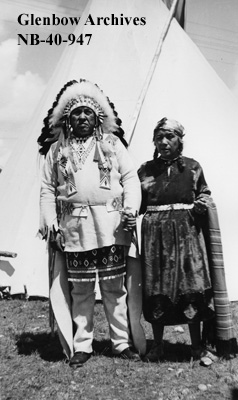Along with the Siksika and Kainai Nations, as well as the Aamskapi Pikuni in Montana, the Piikani Nation comprise the Blackfoot Confederacy, or Siksikaitsitapi. Like the other nations within the confederacy, the Piikani People were traditionally nomadic, following the great bison herds that satisfied the majority of their needs. Due to their pastoral lifestyle, the Piikani’s hunting territory was vast. Stretching along the foothills from Rocky Mountain House to Heart Butte in Montana and then eastward into North America’s Great Plains. Today, the Piikani People occupy two reserves in southern Alberta that encompass more than 46,600 hectares of land, but a fraction of their traditional territory. One is a timber reserve, while the other is where the townsite is located.

Like other members of the Blackfoot Confederacy, the Piikani were a warrior society, often clashing with enemy nations, such as the Crow, Shoshone, Nez Percé, Dakota, and Assiniboine. This fighting only intensified with the introduction of firearms and horses in the 1700s. Warriors were held in high regard within their communities.

Participating in sweat lodges and Sun Dance ceremonies, as well as using medicine bundles and other spiritual practices of purifying the body and soul are important aspects of Piikani culture. These practices were orally passed on through generations, as no written language existed.

It has been said that the Piikani Nation has a history of firsts, as they were the first nation in Alberta to demand the right to vote in provincial elections. They were also the first to allow alcohol onto a reserve, the first to be administrators of their own reserve, and the first to host Indian Day Celebrations as a way to keep their cultural practices alive.

As with many other Indigenous people across Canada, the Piikani Nation’s culture has been threatened by the policies and practices of colonialism, including the Indian Act, residential schools, reserves, and the pass system. These acts have had ongoing impacts with Indigenous communities and have resulted in multi-generational trauma for many Indigenous people. The Truth and Reconciliation Commission and the National Inquiry into Missing and Murdered Indigenous Women are examples of the ongoing work of reconciliation in this country.




















For similar collections of historical photos, please see previous posts about the Tsuut’ina Nation, the Stoney Nakoda Nation, the Siksika Nation, and the Kainai Nation.

The photos above were collected from the Glenbow Archives and the Provincial Archives of Alberta. If you’re interested, additional information can be found for each photograph on the Glenbow website by searching the identification number that is printed on the photo. There is also the option to purchase a high resolution copy. If you search the object number that can be found in the photo captions, you will find additional information about the photographs on the Provincial Archives website. Stay tuned for additional posts featuring historical photos from across Alberta. We’d love to know what you think in the comment section below.




